Today, 12th March 2018, Mauritius celebrates the 50th anniversary of its independence. This blog post is a tribute to our march for our political independence and to the remarkable economic progress we’ve made in just over half a century. It will feature several aspects of our economic and political history, through our philatelic heritage. Another blog post will highlight various features towards the building of a Mauritian nation, again through the lens of our philatelic heritage.
Background
Although Mauritius was known to Arab and Portuguese navigators since the 15th Century, the first permanent settlement was established by the Dutch in 1638. For the next 330 years, Mauritius was successively colonised by:
- The Dutch (1638 – 1658 and 1664 – 1710), who failed to establish a colony;
- The French (1715 – 1810), who capitulated to the British following a fierce battle in 1810; and
- The British (1810 – 1968), who finally handed over political power to a full-fledged Mauritian sovereign Government on 12th March 1968.
A number of stamp issues trace the various periods of our pre-independence history. These are not featured here. My blog called “A Journey to the past through our philatelic heritage” highlight some of them. Another blog series will be dedicated to each of those periods.
Political independence
The foundational events that led the country to independence can be traced back to the 19th Century, with the rising of popular movements, leading to the formation of political parties to represent the voice and interests of the workers, in particular. Political independence was finally acted on 12th March 1968.
In 2008 and 2013, the special commemorative covers issued to mark the 40th and 45th anniversary of independence respectively, portrayed two photos, namely the hoisting of the National Flag and the lowering of the Union Jack, as well as a photo of Sir S. Ramgoolam, the first Prime Minister of Mauritius and Sir John Shaw Rennie, the last British Governor of Mauritius, at the Champ de Mars. There are the only covers showing this solemn moment.
12 March 2008: Celebrating the 40th Anniversary of Independence
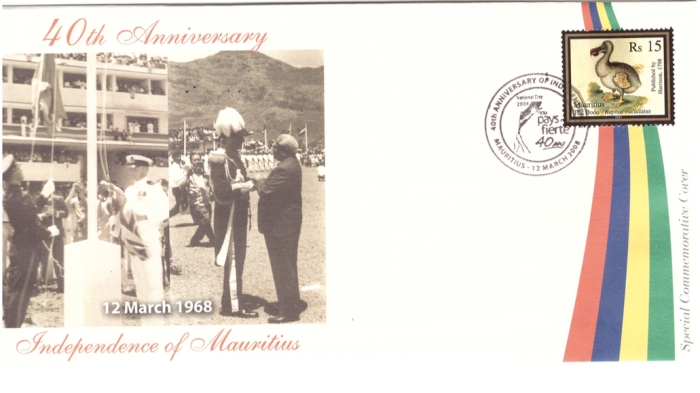
12 March 2013: Celebrating the 45th Anniversary of Independence

Despite becoming a sovereign state in 1968, it is important to highlight that Mauritius remained a constitutional monarchy, with the Queen as the Head of State until the country proclaimed the status of Republic. Her constitutional role was delegated to the Governor-General.
That said, to mark the event, an official first day cover was issued on the 12th March 1968.
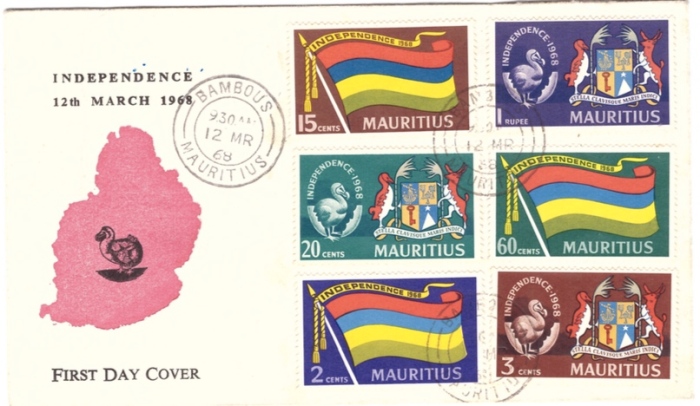
It featured 3 stamps with the Mauritian flag and three stamps with our Coats of Arms. The flag of Mauritius consists of red, blue, yellow and green bands, where:
- Red represents the struggle for freedom and independence.
- Blue represents the Indian Ocean, in the middle of which Mauritius is situated.
- Yellow represents the new light of independence.
- Green represents the agriculture of Mauritius and its colour throughout the 12 months of the year.
The Coat of arms of Mauritius consists of a Dodo Bird and Sambur Deer supporting sugar cane and a shield divided into four sections. The arms were designed in 1906.
On the blazon, the ship (called lymphad or galley) in the first quarter refers to the European settlers of the island, the Portuguese, Dutch, French and English respectively. The second quarter shows three palm trees for the tropical vegetation. The key symbolises the strategic importance of the island. The fourth quarter shows a star, symbol that the island is the star of the Indian Ocean.
The supporters are an (extinct) dodo (Raphus cucullatus) and a sambar deer (Rusa unicolor), symbolising the extinct and present wildlife.
The two green sugar canes indicate the importance of sugar for the local economy.
The motto “Stella Clavisque Maris Indici” is displayed on a ribbon, which means “Star and Key of the Indian Ocean” and is based on the lower half of the arms.
A set of 3 postage stamps was issued to mark the 5th anniversary of independence on 12 March 1973.

On the three stamps (i) the 15cs features the University of Mauritius; (ii) 60cs represents Tea Board building, one of the main agricultural sectors in the 1970s; and (iii) Re. 1. represents the Bank of Mauritius. Each stamp includes a picture of Sir. S. Ramgoolam on the top right hand side.
On 12th March 1978, another first day cover was issued to mark the 10th anniversary of independence, with a set of 15 definitive stamp issues. They highlighted various aspects of our history, mostly related to the pre-independence era. The only stamps that related to the post independence era were: Rs. 15 stamp, featuring the raising of the Mauritian Flag on 12th March 1968 and Rs. 25 stamp, showing the first Mauritian Prime Minister, Sir S. Ramgoolam and the then Governor-General, Sir Veerasamy Ringadoo.



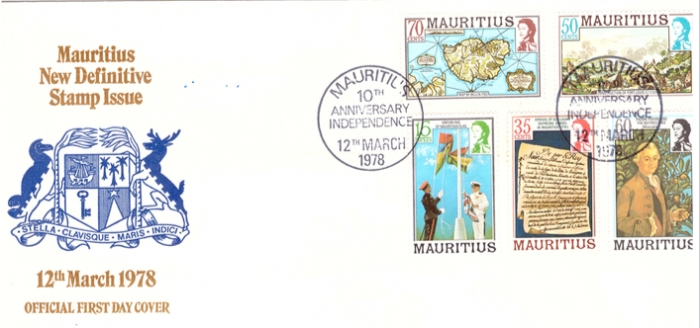
On 12 March 1988, on the occasion of the 20th anniversary of independence, a series of 5 postage stamps was issued. It features (i) on the 25 cs, the University of Mauritius; (ii) the 75 cs stamp, which showed callisthenics, performed during major sports events or during national celebrations such as on independence day; (iii) the Rs 2.50 stamp picturing an athletics show at Sir Maurice Rault stadium; (iv) the Rs. 5 stamp, which illustrates the international airport bearing the name of Sir Seewooosagur Ramgoolam, with an Air Mauritius plane at the parking; and (v) the Rs. 10 featuring Sir Veerasamy Ringadoo, the then Governor-General and Sir Aneerood Jugnauth, the then Prime Minister. The FDC cover features the Coats of Arms of Mauritius.

Mauritius attained full political independence on 12th March 1992, when it became a Republic (although it remained in the Commonwealth). The President replaced to Governor-General. Political power remains with the Prime Minister. On that occasion, an official first day cover was released.
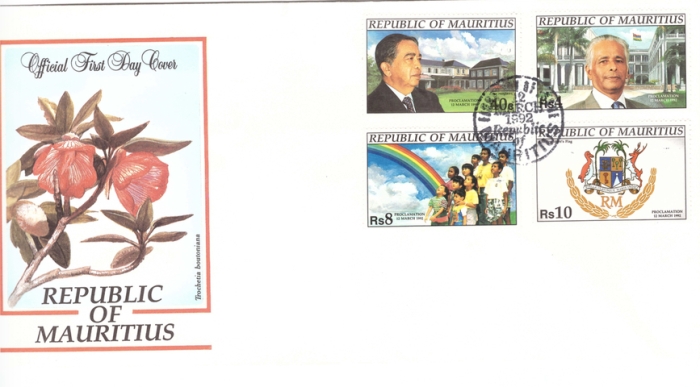
The set of four postage stamps illustrate on (i) the 40cs stamp, Sir Veerasamy Ringadoo, who became the first President of the Republic, with Le Réduit, his residence, as a background; (ii) the Rs. 4 stamp, illustrating the Prime Minister Sir Aneerood Jugnauth, with the Government House in the background; (iii) the Rs. 8 stamp featuring the Mauritian population, a mosaic of multiculturalism, illustrated by a rainbow; and (iv) the Rs 10. stamp, featuring the Coats of Arms of Mauritius, with the initials RM, for Republic of Mauritius. The envelope shows the National flower of Mauritius, the Trochetia.
On the occasion of the 25th anniversary of independence and 1st anniversary of the Republic of Mauritius, a set of postage stamps was issued on 12 March 1993.
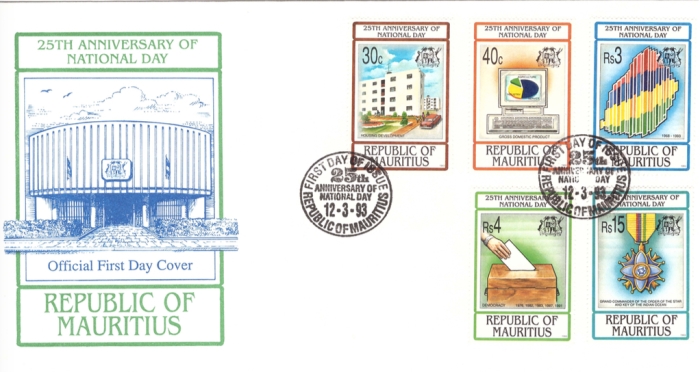
The set of 5 postage stamps featured the main activities of the Mauritian political and economic life over the past 25 years. (i) The 30cs stamp depicts housing development, in particular the housing estates built in different parts of the country; (ii) the 40cs stamp shows the considerable changes in economic conditions of the country, through GDP increase as a result of fast industrialisation; (iii) the Rs. 3 stamp symbolises the colours of the Mauritian flag. Red represents the flowering flamboyant, blue the sea that surrounds the island; yellow the stretches of sandy beaches and green the luxuriant vegetation and sugar cane fields; (iv) th Rs. 4 stamp depicts democracy with a representation of the ballot box; and (v) the Rs. 15 shows the highest national award in the form of an Order, Medal, Badge or Certificate. The highest order depicted on the stamp is the Grand Commander of the Star and Key of the Indian Ocean and is conferred on the President. The FDC shows the National Assembly, seat of Government, situated at the Government House in Port-Louis.
Key political figures:
One notable change on postage stamps after independence was the disappearance of the Queen on most stamps (except for the fisheries issue, released in 1969 and the definitive series issued in 1978 on the occasion of the 10th anniversary of independence). After 1992, following the proclamation of the Republic, the first stamps had the explicit mention of the words “Republic of Mauritius” and then, the coats of arms appeared until 2001. But the main change was an increasing number of stamps showing the importance of political leaders: presidents, (former) prime ministers, and leaders of political parties. This is clearly a sign of stronger and bolder political positioning, in particular in the international arena. Those stamps issues are highlighted below:
Sir Seewoorsagur Ramgoolam, who led the independent movement and became the first Premier when Mauritius obtained self-government in 1965 and was the first Prime Minister of Mauritius at Independence on 12 March 1968. He became Governor General in 1983 until his demise in 1985. He is one of the political figures who has been the most celebrated on postal stamps. He is represented on a number of stamps, notably in the context of the celebrations of the national day but also a number of commemorative issues were released to celebrate his birthday.
For instance, on the occasion of his 80th birthday, a Rs. 15 golden stamp was issued. It features a bust of Sir Sewoosagur Ramgoolam, with the Mauritian flag in the background.

Also, on 18 Sep 2000, to commemorate the Birth Centenary of Sir Sewoosagur Ramgoolam, a set of 4 postage stamps was issued. 
The stamps show various aspects of his career. (i) The Re. 1 stamp portrays SSR welcoming Mother Theresa during her visit to Mauritius in 1984; (ii) At the general elections of 1948, SSR was elected for the first time as a member of the Labour Party. The Rs. 2 stamp shows SSR with a red garland thanking the voters for their confidence; (iii) the Rs. 5 stamp depicts SSR as a young student in London; and (iv) the Rs. 15 stamp features SSR when he became Prime Minister in 1968 after independence. His signature is also shown on the stamp.
Further, on 18 Sep 2006, a Special Commemorative Cover, cancelled with a special cachet was issued to commemorate his 106th birth anniversary. The FDC illustrates a portrait of Sir Seewoosagur Ramgoolam and the steps of the Apravasi Ghat, which is now part of the UNESCO world heritage.

Finally, on 18 September 2010, a Special Commemorative Cover featuring a Rs. 100 gold postage stamp was issued to mark the 110th birth anniversary of Sir Seewoosagur Ramgoolam. The FDC illustrates the statue of SSR, located at Port-Louis Waterfront.

Eminent political personalities
A set of 5 postage stamps was issued on 26 August 1981, illustrating eminent personalities. This was the first issue featuring important figures that marked the social, political and economic landscape of Mauritius.
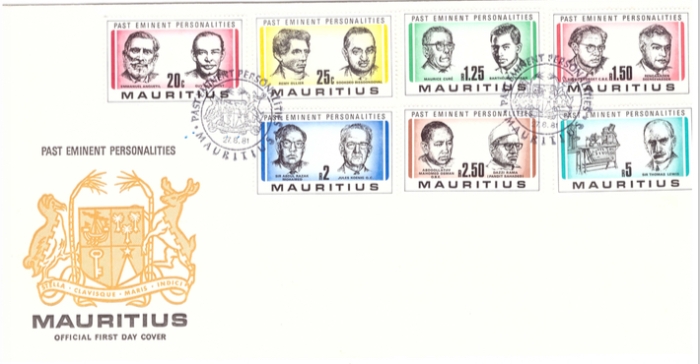
Of these, 4 postage stamps features leading political figures. (i) The 20cs stamp illustrates Emmanuel Anquetil and Guy Rozemond, the leaders of the Mauritius Labour Party in the early 20th century; (ii) The 25 cs stamp features Remy Ollier, a journalist and teacher, who defended the liberty of the press and founded the newspaper La Sentinelle and Sookdeo Bissoondoyal, an eminent politician and one of the leading figures in the independence movement. Bissoondoyal founded the Independent Forward Bloc, a political party. He also attended the Constitutional Conference in London leading towards the independence of Mauritius in 1968; (iii) the Rs.125 stamp showing Dr. Maurice Curé, one of the founding fathers of the Mauritius Labour Party, the main political party that led the country to independence and Barthelemy Ohsan, another early member of the Labour Party, close collaborator of Dr. Maurice Curé. After the second world war, he left the political scene to continue his career as a magistrate; (iv) The Rs. 1.50 stamp shows two high profile political figures, Sir Guy Forget, a member of the Labour Party, who became the President of the party and also served as minister between 1959 and 1968 (before independence) and Renganaden Seeneevassen, a member of the Labour Party, who became the first Minister of Education in 1953; (iv) Rs. 2 stamp shows Sir Abdul Razak Mohammed, a political figure, leader of the Comité d’Action Musulman (a political party), who fought for independence and held several ministerial positions and Jules Koenig, founder of the Mauritius Social Democratic Party (PMSD), one of the oldest political parties of Mauritius. The party was initially not in favour of independence but instead argued for an association with Britain instead; (v) Rs. 2.50 stamp, features Abdoolatiff Mohamed Osman, a pioneering figure in the agricultural cooperative movement , who later became Minister of Agriculture (in 1957) and Dazzi Rama, also known as Pandit Sahadeo, one of the founding fathers of the Mauritius Labour Party, together with Dr. Maurice Curé.
On 4 Sep 2007, a set of four postage stamps were issued on the theme “Anniversaries and Events”.

The Rs. 5 stamp illustrates the 9 personalities who sworn in as Ministers in 1957, following the Agreement reached at the London Conference in February 1957. This system was meant to be a major step towards parliamentary government later. There were several mistakes on that stamp: for example the picture of A.H. Osman appears in place of A.M. Osman, also, the name of Dr. E. Millien was wrongly writted as “Dr. G. Millien and “R. Vaghjee” is written instead of “H.R. Vaghjee”. The stamp was later re-printed, with the correct picture of A. M Osman. However, the other mistakes were not corrected.
The Postal Services issued a stamp of Rs. 10 on 15 April 2006 to commemorate the birth centenary of Professor Basdeo Bissoondoyal, an eminent personality in the field of education and in particular for the Hindu community in Mauritius. He was a scholar, a leader, a preacher and a reformer of the Hindu society. The FDC shows a pile of books written by Prof. Bissoondoyal.
 A Special Commemorative Cover was issued on 1 August 2006 to commemorate the birth centenary of Sir Abdul Razak Mohamed. Born in India on 1 Aug. 1906, Sir A. R. Mohamed came to Mauritius at the age of 22 years to settle as a businessman.
A Special Commemorative Cover was issued on 1 August 2006 to commemorate the birth centenary of Sir Abdul Razak Mohamed. Born in India on 1 Aug. 1906, Sir A. R. Mohamed came to Mauritius at the age of 22 years to settle as a businessman.

Once settled, R. Mohamed was very much engaged with the business community and in political affairs, especially prior to independence. His activities also extended to social services: generously, he provided financial support to needy students, widows and orphans and contributed to set up a number of charitable institutions. He played a significant role in 1945 and 1947 Consultative Committees, set up to advise on the constitution of Mauritius. His main contributions to the Constitution include a Bill of Rights; political safeguards; a 60-member elected assembly; a quota of seat for each main section of the population; and the setting up of an Ombudsman. During his political career, he served as a Municipal Counsellor, Mayor and Senior Minister. He passed away on 8 May 1978.
A special commemorative cover was issued on 17 December 2008 to mark the birth centenary of Sookdeo Bissoondoyal, a primary school teacher, journalist, writer, parliamentarian, Minister and leader of the opposition.
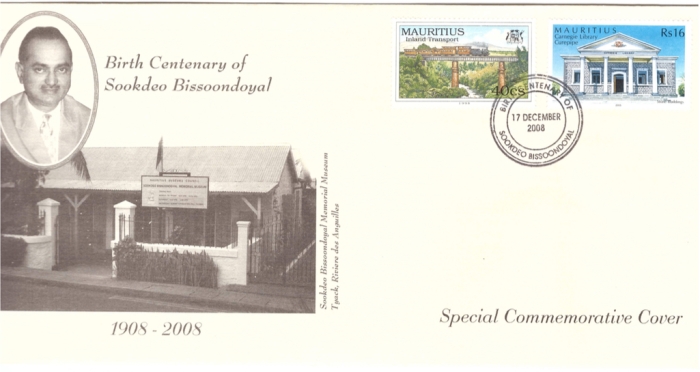
His social and political engagements helped shape the modern history of Mauritius. During his long and distinguished career, he struggled for social justice, the right to vote for his fellow citizens, the protection of their civil rights and for poverty alleviation. He founded a political party, the Independence Forward Bloc, which played a key role in the struggle for independence. The FDC shows a portrait in medallion of S. Bissoondoyal with a background picture of the S. Bissoondoyal Memorial Museum at Tyack, the village where he was born.
A Special Commemorative Cover was issued on 11 April 2010 to mark the birth centenary of Renganaden Seeneevassen, born in Mauritian in 1910.

Prompted by the blatant injustices of colonial Mauritius and imbued with a sense of fairness, R. Seeneevassen left Mauritius in 1935 to read law in England. There, he met great leaders of the Indian independence movement such as Pandit J. Nehru and Mahatma Gandhi and the interaction developed his keen interests in politics. Upon his return to Mauritius, he joined the Labour Party and became of its most influential leaders. His powerful negotiations skills and knowledge of law greatly helped to shape the Constitution of Mauritius. He was the first Mauritian Minister of Education and introduced a new Code of Education to ensure a fair and equitable education system.
On 20 June 2011, a set of 4 postage stamps was issued to mark various anniversaries and events.

Among those, the Rs. 21 stamp, marks the 125th birth centenary of Dr. Maurice Curé an eminent figure of Mauritius political scene, who advocated constitutional reforms and denounced exploitation and injustice during the British rule. He is the founding father of the Mauritius Labour Party, the partly that led the country to independence in 1968. He was elected a member of the Legislative Council in 1946 and 1948 and of the Legislative assembly in 1964.
A Special Commemorative Cover was issued on 3 December 2011 to mark the birth centenary of Seewa Bappoo.

Mr. Bappoo was an influential figure of the socio-cultural landscape of Mauritius. He was also a political figure and participated in the London Constitutional Conference at Lancaster House in 1965, which paved the way for the independence of Mauritius.
The road to economic transformation
Background
When Mauritius acceded to independence in 1968, it was a low-income, monocrop economy: sugar cane production was main economic activity, contributing to almost 90% of export revenues. Current GDP per capita stood at USD 260, unemployment was high (17%) and rising, school enrolment and the average living standard were quite low.
Successive governments laid the foundations for a diversified economy. In the 1970s, Mauritius embarked on an industrialisation journey, leading to the establishment of light manufacturing industries, a vibrant textile industry, and other food processing industries, amongst others. The 1980s were marked by the development of the tourism sector. In the 1990s and 2000s, Mauritius turned to the development of its services sector, with particular focus on financial services and ICT, amongst others. Today, traditional sectors are being transformed into higher value added sector and new sectors, such as real estate development, seafood, knowledge and medical services are being developed.
Today, Mauritius is an upper middle-income country, which aspires to join the ranks of high-income economies, by 2030. In just over 50 years, the economic landscape was significantly transformed: in 2017, the nominal GDP per capita was estimated at USD 9,630 – 37 times higher than when Mauritius began its journey as an independent country in 1968.
Various economic activities
A number of postage stamps issued in the last 50 years highlight the significant contribution of various economic sectors.
On 12 September 2001, a set of 4 postage stamps on the theme “Achievements of the 20th Century” was issued .

The set comprises stamps of (i) Rs. 2, which portrays students during a training session at the Hotel School of Mauritius, set up in 1971 to provide the tourism industry with highly trained personnel; (ii) Rs. 3, showed a light manufacturing activity, a red hot steel bar coming out of a furnace. The steel bar industry played an important role in the building of infrastructure, following independence; (iii) The Rs. 6 stamp portrays a solar energy plant at North Island in Agalega. It was set up in April 1998 to provide energy to 10 houses; (iv) Rs. 10 stamp portrays the logo of the Indian Ocean Rim Association for Regional Cooperation. The Association comprises 19 member states, and aims to promote the interests of Indian Ocean states and to cooperate in various fields. The Secretariat is based in Mauritius. The FDC illustration is an interior view of the Port-Louis Theater.
The Postal Services issued a set of four commemorative stamps to mark the 10th Anniversary of the accession of Mauritius to the status of Republic on 12 March 2002.

The commemorative issue portrays 4 stamps (i) a Re. 1 relates to the development of Port-Louis as a regional hub of the Indian Ocean for trade, warehousing and distribution. The stamp shows the three quay cranes installed in Port-Louis; (ii) Rs. 4 is a composition showing the use of informational technology in the stock market; (iii) Rs. 5 stamp features the construction of the Midlands Dam, which is mainly used for the irrigation of the northern planes; (iv) Rs. 9 stamp portrays the roundabout at Réduit, a major point of exchange for traffic from the centre of the island. The FDC illustrates the President’s flag.
The importance of agriculture
Already in 1969, a series of 5 postage stamps commemorated Telfair’s improvements in the sugar industry (although those relate to the 19th and early 20th century).

On 10 January 1990, to mark the 350th anniversary of the introduction of sugar cane in Mauritius, a new set of 4 postage stamps was released.

The series of stamps feature various activities, such as cane cutting (30cs stamp); an ancient sugar factory (40cs stamp); the introduction of mechanisation, which improved the productivity of cane cultivation (Re. 1 stamp) and a modern sugar factory, which also improved significantly the productivity of the industry, thanks to technology (Rs 25 stamp).
On 15 Nov 2003, on the occasion of the 150th anniversary of the Mauritius Chamber of Agriculture (MCA), a special commemorative cover was issued to mark the significant role played by the MCA in the agricultural and socio-economic development of the country.

The mission of the MCA is to ensure that Mauritian agriculture adapts to global changes, while maintaining active populations in rural areas and to ensure an adequate level of food security. The Chamber, conscious of its strategic importance in the national economy, has shaped a number of initiatives aimed at providing the agricultural sector with sound and permanent structures. This has enabled it to respond positively to numerous challenges. Globalisation and liberalisation of trade, emergence of new technologies, modern agricultural practices and greater concern for the environment are some of the challenges facing the sector.
On 19 Dec 2011 four postage stamps and a FDC were issued on the Tea Industry.
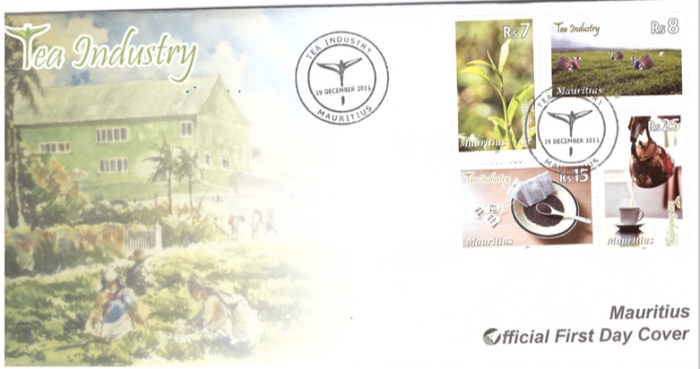
Tea is well anchored in the Mauritian culture and the average consumption of tea on the island is one kg. per head annually. Tea was introduced in Mauritius by a French priest, Father Galloys in 1760. However, under the French rule, tea production was not a priority and even the botanist Pierre Poivre kept it as a museum plant. In the early 19th Century, Sir Robert Farquhar, Governor of Mauritius, encouraged tea cultivation on a commercial basis. One of the pioneers was Raoul Corson. In the 1960s, it was decided to further intensive cultivation in the humid zones. However, in the 1990s, it was decided to convert part of the land into sugar production and tea production declined. Today, there are 3 tea factories, namely Bois Cheri, Corson and La Chartreuse. Production is mainly for domestic production and very few, high grade teas, are exported.
Fisheries resources of Mauritius were featured in a series of 4 postage stamps released on 7 October 1983.

The stamps highlight various activities, namely the 25 cs and Re. 1 stamps, showing a fishermen preparing and using fish traps; the Rs. 5 stamp showing a blue marlin catch, a big game fishing activity and the Rs. 10 showing octopus drying, principally done in Rodrigues.
Industrial activities
On 30 October 1987, a series of 5 postage stamps was issued on the theme “Industrialisation”.

The set of stamps features various economic activities encouraged and developed in Mauritius: (i) the 20cs stamp shows the toy industry; (ii) the 35 cs stamp features a spinning factory, developed to provide local inputs to the textile industry; (iii) the 50cs stamp shows the rattan industry, used to make furniture; (iv) Rs. 2.50 shows the spectacles industry, which even exports to Europe and (v) Rs. 10 stamp, featuring stone carving, a crafting activity that is becoming rarer.
On 10 January 2001, a set of 4 postage stamps was issued to highlight the contribution of the textile industry and its thousands of workers in the economic development of Mauritius.

The set comprises stamps of (i) Re. 1, showing a finished pullover, which is machine-knitted and has been designed by local qualified designers and stylists. Mauritius is one of the leading world exporters of pullovers, mainly to Europe and US; (ii) Rs. r shows a computed aided machinery, used to design, cut and produce patters for high value products; (iii) Rs. 6 depicts a t-shirt folding machine, with a capacity of 400 t-shirts per hour; (iv) Rs. 10 shows an embroidery machine, with a capacity of 800 stitches per minute. The number of points required for a t-shirt ranges from 20,000 to 30,000 stitches.
The Mauritius Chamber of Commerce and Industry (MCCI) played a significant role in advocating and defending the interest of the business community in Mauritius. On 25th January 2000, s series of 4 postage stamps was issued to mark the 150th anniversary of MCCI.

The first day cover illustrates the facade of the seat of the Mauritius Chamber of Commerce and Industry (MCCI), formerly situated on Royal Street, Port-Louis. The set consists of 4 stamps of the following denominations: (i) Re. 1: The Coats of Arms of the MCCI, granted in 1975 and officially awarded in 1979. The Chamber’s moto, which appears on the Coats of Arms is ‘Non nobis, sed patriae’, which means ‘Not for ourselves, but for our motherland’. The blue and yellow colours symbolise trust, confidence and optimism; (ii) The Rs. 2 stamp represents new technologies and the perception of the Chamber for the future (i.e. vision, service and cohesion); (iii) The Rs. 7 stamp shows a painting of the first Secretary of the Chamber, Mr. Francis Channell; and (iv) The Rs. 15 stamp features a painting of Mr. Louis Léchelle, first President of the Chamber (and first Mayor of Port-Louis).
Small crafts and traders
On 1 December 1997, a set of four postage stamps was issued on the theme “petits métiers” to highlight the contribution of local craftsmen to the development of the country.

The set comprises of 4 stamps: (i) a 60cs stamp, showing a wheelwright (saron) at work, who contributed a lot to the development of transport, in particular for carts to carry their loads of sugar to the mills; (ii) Rs. 4 stamp represents a washerman (dobi), washing clothes at the river. Stains and other oily patched were removed using maize cobs (koto maille). This craft has almost disappeared with the arrival of technology and washing machines; (iii) Rs. 5 stamp shows a shipwright (charpentier pirogue), giving a finishing touch to a small fishing boat. The scene was typical of fishing villages, where boat construction was done under banyan trees on the beach; (iv) Rs. 15 stamp shows quarrymen (coupeur corail), woking on blocks of corals to make bricks for the construction of houses and walls. The scene is typical in Rodrigues. The FDC pictures a composite design of the stamps.
On 30 June 2004, the Postal Services issued another set of stamps on the theme ‘petits métiers’, carried out by generations of Mauritians.

(i) Rs. 2 stamp depicts a “ferblantier” (tinsmith), a craft that has evolved to adapt to changing times. Its continuity was guaranteed for its large clientele by craftsmen coming from the same families. They produced a wide range of metal utensils such as watering cans, braziers, buckets, paraffin boxes and letterboxes; (ii) Rs. 7 depicts a ‘cordonnier’ (a cobbler), who repairs and replaces worn soles and heels, very rapidly and at low cost; (iii) Rs. 9 shows a ‘forgeron’ (a blacksmith), now a slowly disappearing craft. They produced a range of rough, robust and cheap tools such as hoes, axe-heads, chisels, spikes etc; (iv) Rs. 15 depicts a ‘vannier’ (a basket maker), where baskets, table mats, straw hats, bags or cases were weaved from sun-dried leaves and fibres from local plants such as coconut, aloe or vacoas.
Tourism
On 12th April 1971, a set of 4 postage stamps was issued on the theme ‘tourist’. It features 4 postage stamps which display various assets of Mauritius as a tourism destination.

(i) The 10cs stamp shows a landscape scenery, with a waterfall with a rainbow; (ii) The 15 cs stamp features another inland scenery of ordinary lifestyle at the time, showing women carrying wood on their heads, crossing a bridge surrounded by sugar cane fields, with montagne Trois Mamelles in the background; (iii) the 60 cs stamp shows a beach scene, with tourists on the beach, ready to go for a boat trip in the lagoon; and (iv) the Rs. 2.50 stamp shows marine life under water, with small coloured fish and corals.
On 25 September 1985, on the occasion of the 10th Anniversary of the World Tourism Organisation, a set of 4 postage stamps was released.
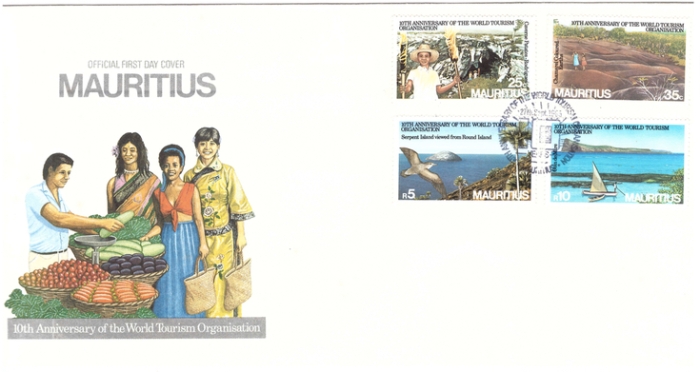
They feature essentially some of the tourism attractions in Mauritius and Rodrigues. (i) The 25cs stamp shows Caverne Patate in Rodrigues, an impressive cave system, of 600 metres, with a few stalagmite and stalactite formations; (ii) The 35 cs stamp shows the seven coloured earth, a geological formation, which is a prominent tourist attraction, situated in Chamarel in Mauritius. The main feature is the different coloured sands, formed by the decomposition of volcanic rocks, that are settled in different layers and small dunes, of about seven different colours (red, brown, violet, green, blue, purple and yellow); (iii) the Rs. 5 stamp shows Serpant island, with a view on Round islands. Those two small islands are nature reserves and are situation in the North of Mauritius; and (iv) The Rs. 10 stamps, which features another small island off the Northern coast of Mauritius, Coin de Mire.
Closely linked to the development of the tourism industry, the national airline company, Air Mauritius, was inaugurated in 1977.
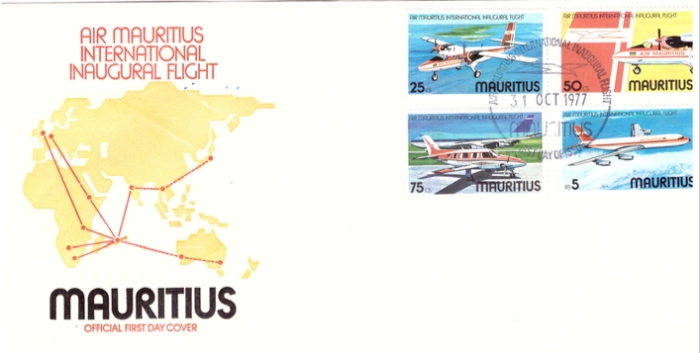

On 14 June 1993, a set of 4 postage stamps was issued to mark the 25th anniversary of Air Mauritius.


(i) The 40cs represents a Bell 206B Jet Ranger helicopter, put in operations by Air Mauritius in 1985; (ii) Rs. 3, showing the taking off of a Boeing 747 SP, in operation since 1984. The aircraft was used for the first non-stop flights between Mauritius, Paris, Rome and Zurich; (iii) Rs. 4, showing an ATR 42, used for inter-island services, linking Mauritius to Reunion Isl. and Rodrigues. The plane was put in service in 1986; (iv) Rs. 10, showing a Boeing 767-200 ER, baptised the City of Port-Louis. This aircraft held the world record in 1988 for the longest non-stop distant. The FDC shows Air Mauritius route map.
In 2017, Air Mauritius celebrated in 50th anniversary and released a special commemorative cover to mark the event. Today, Air Mauritius is one of the largest Mauritian companies, with over 3,000 employees. It covers 25 direct destinations and serve more than 100 others, through various hubs, on 4 continents.

Financial services
On 1 September 1988, a set of 4 postage stamps was released to mark the 150 anniversary of the Mauritius Commercial Bank, the oldest and largest financial institution in Mauritius.

The MCB is also the oldest banking institution south of the Sahara and one of the oldest banks of the Commonwealth to have preserved its original name. The bank was an initiative by a group of traders of the capital, headed by Mr. James Blyth and Mr. William Hollier Griffiths, who wanted to establish an alternative to the Bank of Mauritius, which they felt favoured the planters on the island. The bank started business with an authorised capital of 100,000 pounds sterling, around 500,000 piastres, in premises situated at rue de Paris, subsequently rue Desforges, now Sir Seewoosagur Street. The set of postage stamps feature the following: (i) the 25 cs shows the MCB building in Port-Louis as from 1981; the Re. 1 stamp show of old premises of the bank as they were in 1897; (iii) the Rs. 1.25 stamp shows the Coats of Arms of the Bank; and (iv) the Rs. 25 features a bank note issued by the MCB in 1838.
On 29 October 1992, a set of 4 postage stamps was issued on the occasion of the silver jubilee of the Bank of Mauritius. The BoM Ordinance 1966 provided for the establishment of the Bank of Mauritius as the country’s central bank.

The Bank started operations in 1967 at a time when Mauritius was still a British colony. (i) 40cs shows the BoM building, located at the corner of Sir William Newton Street and Royal Street. The building was inaugurated on 31 March 1972; (ii) Rs 4 shows the Dodo Gold Bullion Coin, issued on 12 November 1988, a landmark in the history of coinage in Mauritius. The Dodo Gold coins are available in separate units containing respectively one ounce, a quarter once, and one-tenth ounce of pure gold. They reflect the country’s drive at entering a market which has been the exclusive preserve of a few countries; (iii) Rs 8 shows Mauritian bank notes. Once of the principal function of the Central Bank is to ensure the adequate supply of notes and coins. In 1934, a Board of Commissioners of Currency was set up to issue for the first time, the Mauritian Rupee currency notes, under a fixed Sterling-Rupee standard. On 4th Sep. 1967, the Bank of Mauritius issued a first set of 4 banknotes in denominations of Rs. 50, Rs 25, Rs 10 and Rs 5 respectively. As from 18 Sep 1985, taking cognisance of the changing needs of the business community, new bank notes with a new series comprising of 8 denominations, namely Rs 1000, Rs 500, Rs 200, Rs 100, Rs 50, Rs 20, Rs 10, Rs 5. (iv) Rs. 15 stamp shows the foreign exchange reserves between 1967 and 1992. These reserves are generated from exports of goods and services. The BoM manages those reserves.
On 6 September 2017, Mauritius Post issued an Official First Day Cover to mark the 50th anniversary of the creation of the Bank of Mauritius.
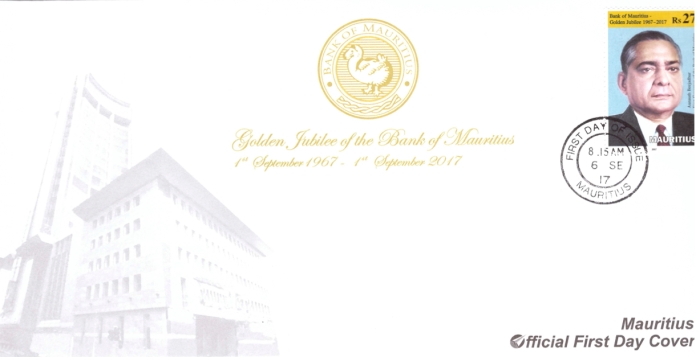
A unique Rs. 27 stamp, featuring the first Governor of the Bank of Mauritius , Mr Aunauth Beejadhur, was issued. The cover shows also the BoM building, situated in Sir William Newton Street, Port-Louis. Prior to the creation of the BoM, the Board of the Commissioners of Currency was responsible for the issue of currency in Mauritius. It was established in 1849 and put an end to the practice of ‘free banking’ that had prevailed all throughout the 18th Century. An Order of the Council prescribed the Mauritian Rupee as legal tender as from 1876. The Bank of Mauritius replaced the Board, and was officially inaugurated by the then Governor of Mauritius, Sir John Shaw Rennie, on 1 September 1967. The primary objective of the BoM is to maintain price stability and to promote orderly and balanced economic development. It also regulated credit and currency to ensure the stability of the financial system.
Telecommunications
Telecommunications played a major role in the development of Mauritius. In 1983, a set of 4 postage stamps was issued in the context of the World Communications Year.

It featured various aspects of communications (telephone, telegraph, satellite and air ballon), which all contributed to connect Mauritius to disenclave a small island like Mauritius and connect it to the world.
On 25 November 1993, a set of 4 commemorative postage stamps was issued on Telecommunications to mark the celebration of the 100 years of external telecommunications by Mauritius Telecoms.
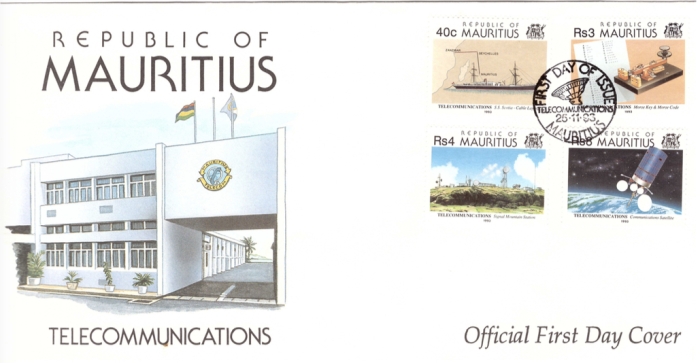
The stamps depicts the evolution of telecoms in Mauritius: (i) 40cs stamp depicts the laying submarine cables between Mauritius and Seychelles by S.S Scotia, marking the first external communications with the rest of the world in 1893. The submarine cable can still be seen at Cassis Station; (ii) Rs. 3 shows the morse key and code, invented by Samuel Morse in 1844. The first message from Mauritius was keyed on the Mauritius submarine telegraph to the Majesty Queen Victoria on 25 November 1893 at 14.45 hours and a reply was received at 17.15 hours; (iii) Rs. 4, shows Signal Mountain station, which serves as a relay station for microwave links between Mauritius and Seychelles; (iv) Rs. 8, showing a communication satellite, in operation in Mauritius since 1975. The FDC depicts Cassis Station.
A Special Commemorative Cover was issued on 29 May 2014 to mark the 25th anniversary of mobile telephony in Mauritius.

With the advent of first mobile telephony operation in Mauritius and the Southern Hemisphere on 29 May 1989, Emtel Ltd has transformed positively the way of life of the people. Over the past 25 years, the company has made a significant contribution to social and economic development by connecting even the remotest corners of Mauritius, including Rodrigues and Agalega, while enhancing communication to reach out to the world. With customers needs always at the fore of its priorities, the pioneering spirit of Emtel Ltd has successfully delivered a number of milestones in the history of telecommunications.
Hello
Thank you very much for these marvelous words and wonderful pictures. I would be thankful if you could share the complete picture of Air Mauritius with the Twin Otter. It appears to be be cropped if I am not wrong. Thank you
LikeLike
Perfect just what I was searching for! .
LikeLike
thanks a lot! cheers
LikeLike
Thank you for writing thiis
LikeLike